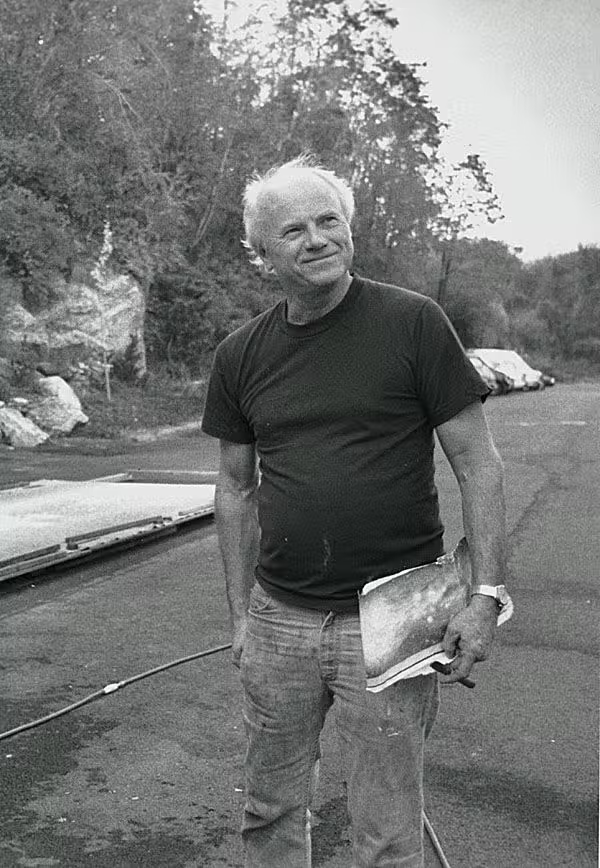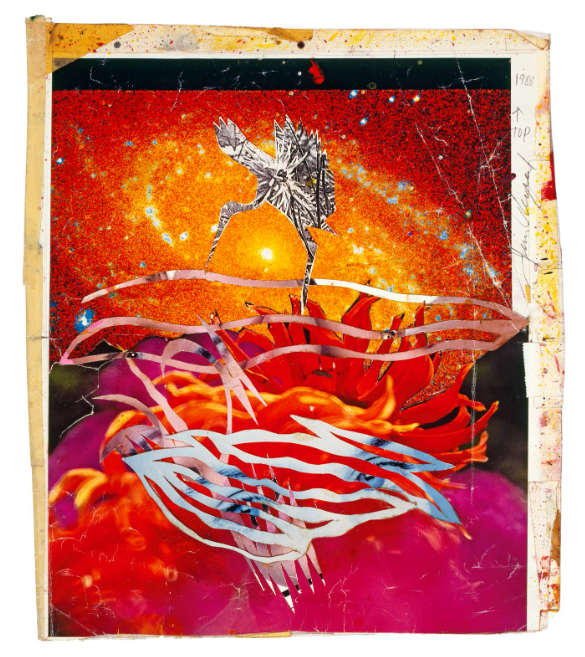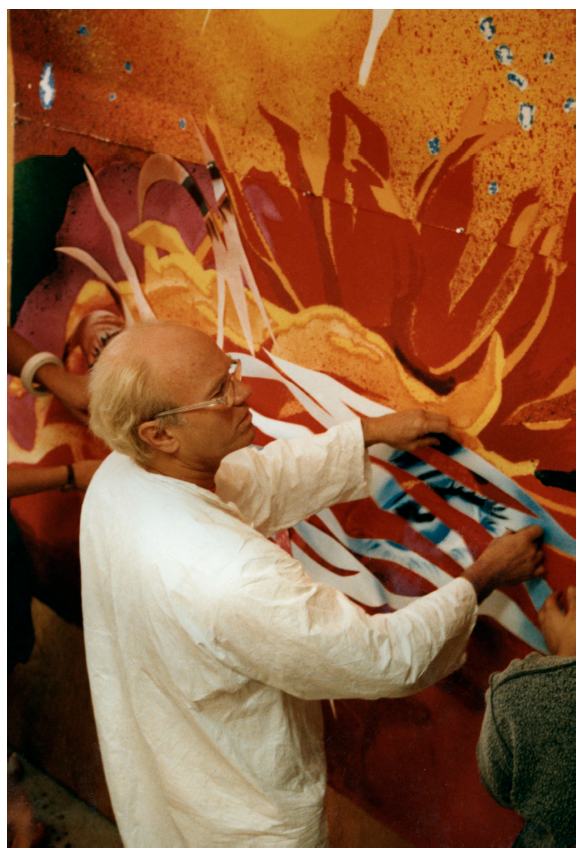Works from the James Rosenquist Estate
New York Auction 15 February 2024
200
James Rosenquist
Circles of Confusion, from 11 Pop Artists, Volume I (G. 10)
Estimate $800 - 1,200
Sold for $2,794
Create your first list.
Select an existing list or create a new list to share and manage lots you follow.
201
James Rosenquist
Whipped Butter for Eugene Ruchin, from 11 Pop Artists, Volume II (G. 11)
Estimate $400 - 600
Sold for $3,556
Create your first list.
Select an existing list or create a new list to share and manage lots you follow.
202
James Rosenquist
For Love, from 11 Pop Artists, Volume III (G. 13)
Estimate $1,000 - 2,000
Sold for $2,540
Create your first list.
Select an existing list or create a new list to share and manage lots you follow.
203
James Rosenquist
F-111 (Leo Castelli Gallery)
Estimate $800 - 1,200
Sold for $6,350
Create your first list.
Select an existing list or create a new list to share and manage lots you follow.
204
James Rosenquist
A Drawing While Waiting for an Idea (S. 6, G. 14)
Estimate $800 - 1,200
Sold for $2,794
Create your first list.
Select an existing list or create a new list to share and manage lots you follow.
205
James Rosenquist
Morning Mirror (G. 15)
Estimate $600 - 900
Sold for $2,286
Create your first list.
Select an existing list or create a new list to share and manage lots you follow.
206
James Rosenquist
Circles of Confusion & Lite Bulb
Estimate $600 - 900
Sold for $3,556
Create your first list.
Select an existing list or create a new list to share and manage lots you follow.
207
James Rosenquist
Small Doorstop
Estimate $80,000 - 120,000
Sold for $95,250
Create your first list.
Select an existing list or create a new list to share and manage lots you follow.
208
James Rosenquist
Forehead I; and Forehead II (G. 20 & 21)
Estimate $2,000 - 3,000
Sold for $3,048
Create your first list.
Select an existing list or create a new list to share and manage lots you follow.
209
James Rosenquist
See-Saw, Class Systems (G. 22)
Estimate $500 - 700
Sold for $2,794
Create your first list.
Select an existing list or create a new list to share and manage lots you follow.
210
James Rosenquist
Night Smoke II (S. 15, G. 26)
Estimate $1,500 - 2,500
Sold for $3,302
Create your first list.
Select an existing list or create a new list to share and manage lots you follow.
211
James Rosenquist
Spaghetti (G. 31)
Estimate $3,000 - 5,000
Sold for $10,795
Create your first list.
Select an existing list or create a new list to share and manage lots you follow.
212
James Rosenquist
Tumbleweed (G. 32)
Estimate $600 - 900
Sold for $889
Create your first list.
Select an existing list or create a new list to share and manage lots you follow.
213
James Rosenquist
Delivery Hat, from Cold Light Suite (G. 35)
Estimate $400 - 600
Sold for $1,651
Create your first list.
Select an existing list or create a new list to share and manage lots you follow.
214
James Rosenquist
Mirrored Flag; Moon Beam Mistaken for the News; and Cold Light, from Cold Light Suite (G. 37-38 & 40)
Estimate $3,000 - 5,000
Sold for $7,620
Create your first list.
Select an existing list or create a new list to share and manage lots you follow.
215
James Rosenquist
Earth and Moon, from Cold Light Suite (G. 43)
Estimate $800 - 1,200
Sold for $5,715
Create your first list.
Select an existing list or create a new list to share and manage lots you follow.
216
James Rosenquist
Pulling Out (G. 47)
Estimate $600 - 900
Sold for $3,048
Create your first list.
Select an existing list or create a new list to share and manage lots you follow.
217
James Rosenquist
Hey! Let's Go for a Ride (G. 55)
Estimate $3,000 - 5,000
Sold for $9,525
Create your first list.
Select an existing list or create a new list to share and manage lots you follow.
218
James Rosenquist
Brighter than the Sun (G. 57)
Estimate $600 - 900
Sold for $3,048
Create your first list.
Select an existing list or create a new list to share and manage lots you follow.
219
James Rosenquist
Short Schedule (S. 1972.05, G. 61)
Estimate $500 - 700
Sold for $2,540
Create your first list.
Select an existing list or create a new list to share and manage lots you follow.
220
James Rosenquist
Banner #1
Estimate $3,000 - 5,000
Sold for $3,302
Create your first list.
Select an existing list or create a new list to share and manage lots you follow.
221
James Rosenquist
Banner #2
Estimate $3,000 - 5,000
Sold for $9,525
Create your first list.
Select an existing list or create a new list to share and manage lots you follow.
222
James Rosenquist
First [When was the first time you had your eyes examined?] (G. 64)
Estimate $800 - 1,200
Sold for $2,286
Create your first list.
Select an existing list or create a new list to share and manage lots you follow.
223
James Rosenquist
Off the Continental Divide (S. 17, G. 69)
Estimate $7,000 - 10,000
Sold for $6,985
Create your first list.
Select an existing list or create a new list to share and manage lots you follow.
224
James Rosenquist
F-111 (south) (west) (north) (east) (G. 73)
Estimate $30,000 - 50,000
Sold for $228,600
Create your first list.
Select an existing list or create a new list to share and manage lots you follow.
225
James Rosenquist
Tampa—New York 1188 (G. 81)
Estimate $2,000 - 3,000
Sold for $9,525
Create your first list.
Select an existing list or create a new list to share and manage lots you follow.
226
James Rosenquist
Head Stand (G. 777, G. 104)
Estimate $800 - 1,200
Sold for $2,286
Create your first list.
Select an existing list or create a new list to share and manage lots you follow.
227
James Rosenquist
Terrarium (G. 154)
Estimate $1,000 - 1,500
Sold for $2,286
Create your first list.
Select an existing list or create a new list to share and manage lots you follow.
228
James Rosenquist
Industrial Cottage (G. 159)
Estimate $1,000 - 1,500
Sold for $2,286
Create your first list.
Select an existing list or create a new list to share and manage lots you follow.
229
James Rosenquist
Sheer Line (S. 1979.41, G. 163)
Estimate $800 - 1,200
Sold for $4,826
Create your first list.
Select an existing list or create a new list to share and manage lots you follow.
230
James Rosenquist
Idea I; and Idea II (G. 165 & 166)
Estimate $600 - 900
Sold for $1,397
Create your first list.
Select an existing list or create a new list to share and manage lots you follow.
231
James Rosenquist
Doorskin (G. 168)
Estimate $1,000 - 2,000
Sold for $1,651
Create your first list.
Select an existing list or create a new list to share and manage lots you follow.
232
James Rosenquist
Chambers (S. 19, G. 173)
Estimate $800 - 1,200
Sold for $1,270
Create your first list.
Select an existing list or create a new list to share and manage lots you follow.
233
James Rosenquist
Dog Descending a Staircase (S. 20, G. 174)
Estimate $6,000 - 9,000
Sold for $16,510
Create your first list.
Select an existing list or create a new list to share and manage lots you follow.
234
James Rosenquist
High Technology and Mysticism: A Meeting Point (G. 180-186)
Estimate $4,000 - 6,000
Sold for $4,826
Create your first list.
Select an existing list or create a new list to share and manage lots you follow.
235
James Rosenquist
The Glass Wishes: eight plates (G. 1014-1016, 1018-1019, 1021, 1023 & 1024, G. 187-189, 191-192, 194, 196 & 197)
Estimate $4,000 - 6,000
Sold for $3,810
Create your first list.
Select an existing list or create a new list to share and manage lots you follow.
236
James Rosenquist
The Kabuki Blushes, from Secrets in Carnations (G. 206)
Estimate $2,000 - 3,000
Sold for $7,620
Create your first list.
Select an existing list or create a new list to share and manage lots you follow.
237
James Rosenquist
Welcome to the Water Planet (G. 211)
Estimate $4,000 - 6,000
Sold for $10,160
Create your first list.
Select an existing list or create a new list to share and manage lots you follow.
238
James Rosenquist
The Prickly Dark (G. 212)
Estimate $3,000 - 5,000
Sold for $6,096
Create your first list.
Select an existing list or create a new list to share and manage lots you follow.
239
James Rosenquist
The Bird of Paradise Approaches the Hot Water Planet, from Welcome to the Water Planet (G. 214)
Estimate $8,000 - 12,000
Sold for $44,450
Create your first list.
Select an existing list or create a new list to share and manage lots you follow.
240
James Rosenquist
Time Door Time D'Or, from Welcome to the Water Planet (G. 218)
Estimate $10,000 - 15,000
Sold for $30,480
Create your first list.
Select an existing list or create a new list to share and manage lots you follow.
241
James Rosenquist
Space Dust, from Welcome to the Water Planet (G. 219)
Estimate $10,000 - 15,000
Sold for $21,590
Create your first list.
Select an existing list or create a new list to share and manage lots you follow.
242
James Rosenquist
Caught One Lost One for the Fast Student or Star Catcher, from Welcome to the Water Planet (G. 222)
Estimate $2,000 - 3,000
Sold for $7,620
Create your first list.
Select an existing list or create a new list to share and manage lots you follow.
243
James Rosenquist
House of Fire (G. 223)
Estimate $15,000 - 25,000
Sold for $25,400
Create your first list.
Select an existing list or create a new list to share and manage lots you follow.
244
James Rosenquist
The Light Bulb Shining (G. 228)
Estimate $2,500 - 3,500
Sold for $7,620
Create your first list.
Select an existing list or create a new list to share and manage lots you follow.
245
James Rosenquist
Speed of Light
Estimate $15,000 - 25,000
Sold for $39,370
Create your first list.
Select an existing list or create a new list to share and manage lots you follow.
246
James Rosenquist
The Stowaway Peers Out at the Speed of Light
Estimate $15,000 - 25,000
Sold for $27,940
Create your first list.
Select an existing list or create a new list to share and manage lots you follow.
247
James Rosenquist
The Xenophobic Movie Director or Our Foreign Policy
Estimate $7,000 - 9,000
Sold for $6,985
Create your first list.
Select an existing list or create a new list to share and manage lots you follow.
248
James Rosenquist
The Memory Continues but the Clock Disappears
Estimate $2,000 - 3,000
Sold for $10,160
Create your first list.
Select an existing list or create a new list to share and manage lots you follow.
249
James Rosenquist
Time Lines
Estimate $2,000 - 3,000
Sold for $7,938
Create your first list.
Select an existing list or create a new list to share and manage lots you follow.


